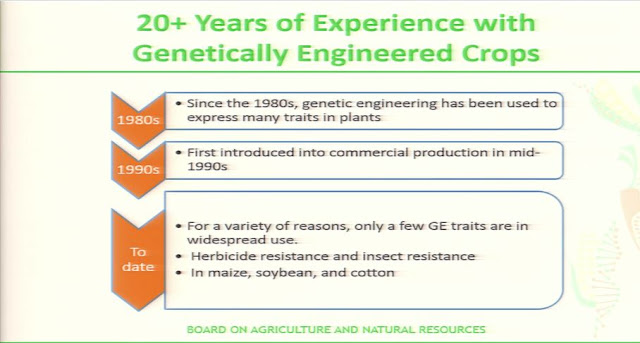I recently listened to a presentation at work on the pink cotton bollworm. This is a huge pest in the world of cotton. The female lays its eggs in a cotton boll (the fruit that houses the cotton lint). As the eggs hatch the larvae eat through the cotton lint to feed on the cotton seeds located in the boll. The insects are doing damage to the lint and the seed both of which are used for cotton fabric and seed oil, receptively. They also put wounds on the bolls that allow other insects and fungi to get in and cause additional damage.
 |
| https://en.wikipedia.org/wiki/Pink_bollworm |
The first generation of GM bollworm control came from Monsanto in 1996 and was called Bollgard I. This was a single gene that controlled bollworms with a Bt protein. This is the same protein that is approved and still used by many organic farmers. Instead of applying the protein on the plants, the pants naturally produce this protein. When a pest ingests the Bt protein, pores (or holes) form in the insect's gut, ultimately killing them while being completely harmless to humans. This product was amazing and cotton farmers quickly adopted this new technology.
The problem is one gene can be overcome by a pest, bacteria, or virus. I want to make a few things clear going forward. In this story, a single gene was inserted into plants through a genetically modified approach. Conventional breeding is used to do the same thing. For instance there are many cultivars from various crops that have one gene bred to control something. When I worked in tobacco, the "N" gene was conventionally bred into commercial lines to give tobacco mosaic virus resistance.
This story is not a GM vs conventional breeding thing. The real issue that these technologies compliment each other and both give farmers the tools to reduce the impacts from insects and disease. We are facing a world wide problem today of bacteria developing antibiotic resistance. The same thing can happen with insects and crop diseases. They are always working to find ways to overcome the defenses we put into plants. The comparison of bacteria and antibiotics and vrops and disease/pests is so similar. The reason we are developing antibiotic resistance so fast is because we are overusing antibiotics and even when we need them we don't always follow the instructions and take them till completion. The same goes with these insect and disease resistance genes. The tools work, but good practices must be followed to keep that tool working.
Bollgard I was an example where the bollworm overcame resistance. Bollgard II followed Bollgard 1 and this new product contained 2 genes that control bollworms instead of just one. Multiple genes, or stacks are always preferred because it is much harder to overcome. That still means the "prescription" needs to be followed to make the product last as long as possible. The prescription in this case is insect resistance management (IRM), Integrated Pest Management (IPM) is another popular term. Even though the plants have a gene to control these worms, we want to do other things on the farm to protect the product and not give the worms a chance to develop resistance. IPM to relies on multiple forms of control rather than just relying on couple genes no matter if those genes come from a conventional method or GM approach. Crop rotation, using beneficials, using correct cultivation methods, and using the right chemical at the right time are all other aspects of managing a pest.
Bollgard II is an incredible product. However as Spiderman says, "with great power comes great responsibility." This technology has great power, but there may be cracks forming in certain regions because that IPM "prescription" was not followed. In Gujarat, India bollworms successfully became resistant to Bollgard I. And now there are at least some rumors that boll worms have resistance to Bollgard II in Gujarat, India as well. One source: http://www.thehindubusinessline.com/economy/agri-business/wily-pink-bollworm-survives-monsantos-bollgardii/article7814810.ece
The US really pushes IPM and in some places are working towards eradication of pink bollworm. In parts of India these practices are not being followed and we can see the results. This video highlights what happens when when we have great technology, but we don't bring it all together. A colleague shared this video which is mind is mind-blowing and sad. The video is of a cotton harvest in Gujarat, India. Look closely and you have wonder whether they are harvesting cotton or pink bollworms.
There are many tools at a farmers disposal to combat insects, disease, drought, and other challenges. All of these tools including, biotech, conventional breeding, cultivation practices, insecticide and pesticide use, beneficials, and others are indispensable. This story highlights what happens if only a couple of the tools are used and others are ignored. All the work the research companies and the farmers are doing everyday are keeping yields sustainable and growing, but disease and insects are not sitting idle.
Parts of Arizona have shown what can be achieved if IPM is used correctly. There some farmers don't even know what a pink bollworm looks like. Hopefully all regions of the world will work to make this chart reality everywhere.
 |
| http://ipmwest.blogspot.com/2014/01/pest-loss-survey-in-cotton-quantifies.html |
Resources:
More info on IPM:





























